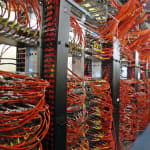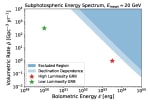The IceCube Collaboration has teamed up with NASA’s High-Energy Astrophysics Science Archive Research Center (HEASARC) to share 10 years of IceCube data with the public. Supported by the Astrophysics Division of NASA’s Science Mission Directorate and a service of the Astrophysics Science Division at NASA’s Goddard Space Flight Center (GSFC), the HEASARC is the primary […]
Research
New machine learning method dramatically improves IceCube data processing
Machine learning has arrived at the South Pole. Well, not literally, but machine learning is now being applied to data collected at the South Pole by the IceCube Neutrino Observatory, an unconventional telescope made up of thousands of sensors buried in ice. IceCube’s goal is to detect tiny, nearly massless particles called neutrinos that fly […]
IceCube looks for low-energy neutrinos from gravitational wave events
Ever since the first detection of gravitational waves by LIGO and Virgo, the IceCube Neutrino Observatory has been searching for neutrino counterparts to gravitational waves. Detecting both gravitational waves and neutrinos from the same source would be a groundbreaking step in multimessenger astronomy, the field that uses multiple kinds of cosmic messengers to see the […]
For the first time, IceCube looks for neutrinos from solar flares
Our sun shines not only in light but also in neutrinos. These tiny, chargeless, and nearly massless particles are produced deep in the sun’s core, but we also expect them to be created in the solar atmosphere, either by collisions of cosmic rays or during solar flares. The IceCube Neutrino Observatory at the South Pole, a […]
New algorithm improves IceCube’s pointing accuracy
When the IceCube Neutrino Observatory sees a high-energy neutrino from outer space, IceCube researchers want to know where it came from. The unconventional “telescope” uses a three-dimensional grid of supersensitive light sensors buried under the ice at the South Pole to detect signals from these tiny, nearly massless fundamental particles, which rarely interact and can […]
IceCube detection of a high-energy particle proves 60-year-old theory
On December 8, 2016,* a high-energy particle called an electron antineutrino hurtled to Earth from outer space at close to the speed of light carrying 6.3 petaelectronvolts (PeV) of energy. Deep inside the ice sheet at the South Pole, it smashed into an electron and produced a particle that quickly decayed into a shower of […]
Neutrino astronomy and glaciology meet at IceCube’s Polar Science Workshop
The IceCube Neutrino Observatory has a uniquely close relationship with ice. The telescope needs ice—and a lot of it—to detect the astrophysical neutrinos it was built to study. In fact, most of IceCube’s instruments are embedded in a cubic kilometer of ice at the South Pole. Construction of the detector required drilling 2.5 kilometers straight […]
IceCube pipeline responds quickly to transient phenomena reported by other observatories
The IceCube Neutrino Observatory, an array of over 5,000 light sensors embedded in a cubic-kilometer of ice at the South Pole, was built to detect astrophysical neutrinos: mysterious and nearly massless particles that carry information about the most energetic events in the cosmos. Every time IceCube sees something that might be a cosmic neutrino, it […]
New IceCube analysis sets upper limits on time-dependent neutrino sources
The IceCube Collaboration searches for neutrino sources using a variety of analysis methods. In a paper submitted yesterday to The Astrophysical Journal, the collaboration describes a time-dependent all-sky scan using five years of IceCube data as well as a specific analysis of blazar 3C 279. The analyses did not reveal any new neutrino point sources. […]
Can a high-energy neutrino detector see low-energy neutrinos?
In a paper submitted recently to JCAP, the IceCube Collaboration describes a search for sub-TeV neutrino emission from astrophysical “transient” sources. This is the first transient result from IceCube to use all neutrino flavors in the 1-100 GeV energy region. In the absence of any observed sources in three years of archival IceCube data, the researchers established new limits on the volumetric rate of transients. […]









